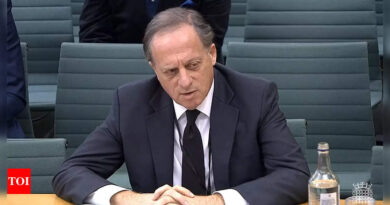Mars: Four Nasa volunteers to spend 1 year in Houston Mars simulator – Times of India
WASHINGTON: Living on Mars wasn’t exactly a childhood dream for Canadian biologist Kelly Haston, though she’ll soon spend a year preparing for just that. “We are just going to pretend that we’re there,” the 52-year-old told AFP, summing up her participation in an exercise simulating a long stay on the Red Planet.
At the end of June, she will be one of the four volunteers stepping into a Martian habitat in Houston, Texas that will be their home for the next 12 months. “It still sometimes seems a bit unreal to me,” she laughs.
For Nasa, which has carefully selected the participants, these long-term experiments make it possible to evaluate the behaviour of a crew in an isolated and confined environment, ahead of a real mission in future.
Participants will face equipment failures and water limitations, the space agency has warned – as well as some “surprises,” according to Haston. Their communications with the outside world will suffer from the delays that exist between Earth and Mars – up to 20 minutes one-way, depending on the planets’ positions – and 40 minutes two ways. “I’m very excited about this, but I’m also realistic for what the challenge is,” says the research scientist, whose status as a permanent resident of the United States made her eligible for the program.
The habitat, dubbed Mars Dune Alpha, is a 3D printed 1,700 square-foot facility, complete with bedrooms, a gym, common areas, and a vertical farm to grow food. “It’s actually surprisingly spacious feeling when you go inside it,” said Haston, who visited last year before her participation was confirmed. “And we do have an outdoor area as well where we will mimic spacewalks or Mars walks.” This area, separated by an airlock, is filled with red sand, though it is still covered rather than being open air.
The crew will have to don their suits to do “spacewalks” – “probably one of the things that I’m looking forward to the most,” says Haston, a registered member of the Mohawk Nation.
The four members of the mission – herself, an engineer, an emergency doctor and a nurse – did not know each other before the selection process, but have since met. “We really are close-knit already,” says Haston, who has been named commander of the group, adding she looks forward to seeing these relationships grow even stronger.
This mission is the first of a series of three planned by Nasa, grouped under the title CHAPEA (Crew Health and Performance Exploration Analog).
At the end of June, she will be one of the four volunteers stepping into a Martian habitat in Houston, Texas that will be their home for the next 12 months. “It still sometimes seems a bit unreal to me,” she laughs.
For Nasa, which has carefully selected the participants, these long-term experiments make it possible to evaluate the behaviour of a crew in an isolated and confined environment, ahead of a real mission in future.
Participants will face equipment failures and water limitations, the space agency has warned – as well as some “surprises,” according to Haston. Their communications with the outside world will suffer from the delays that exist between Earth and Mars – up to 20 minutes one-way, depending on the planets’ positions – and 40 minutes two ways. “I’m very excited about this, but I’m also realistic for what the challenge is,” says the research scientist, whose status as a permanent resident of the United States made her eligible for the program.
The habitat, dubbed Mars Dune Alpha, is a 3D printed 1,700 square-foot facility, complete with bedrooms, a gym, common areas, and a vertical farm to grow food. “It’s actually surprisingly spacious feeling when you go inside it,” said Haston, who visited last year before her participation was confirmed. “And we do have an outdoor area as well where we will mimic spacewalks or Mars walks.” This area, separated by an airlock, is filled with red sand, though it is still covered rather than being open air.
The crew will have to don their suits to do “spacewalks” – “probably one of the things that I’m looking forward to the most,” says Haston, a registered member of the Mohawk Nation.
The four members of the mission – herself, an engineer, an emergency doctor and a nurse – did not know each other before the selection process, but have since met. “We really are close-knit already,” says Haston, who has been named commander of the group, adding she looks forward to seeing these relationships grow even stronger.
This mission is the first of a series of three planned by Nasa, grouped under the title CHAPEA (Crew Health and Performance Exploration Analog).




